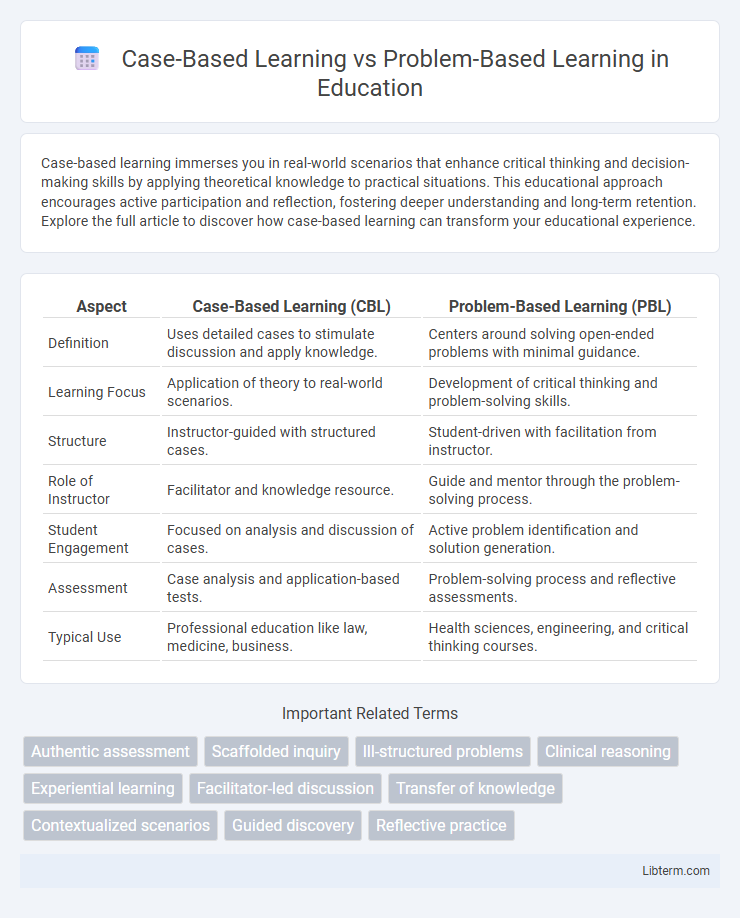Case-based learning immerses you in real-world scenarios that enhance critical thinking and decision-making skills by applying theoretical knowledge to practical situations. This educational approach encourages active participation and reflection, fostering deeper understanding and long-term retention. Explore the full article to discover how case-based learning can transform your educational experience.
Table of Comparison
| Aspect | Case-Based Learning (CBL) | Problem-Based Learning (PBL) |
|---|---|---|
| Definition | Uses detailed cases to stimulate discussion and apply knowledge. | Centers around solving open-ended problems with minimal guidance. |
| Learning Focus | Application of theory to real-world scenarios. | Development of critical thinking and problem-solving skills. |
| Structure | Instructor-guided with structured cases. | Student-driven with facilitation from instructor. |
| Role of Instructor | Facilitator and knowledge resource. | Guide and mentor through the problem-solving process. |
| Student Engagement | Focused on analysis and discussion of cases. | Active problem identification and solution generation. |
| Assessment | Case analysis and application-based tests. | Problem-solving process and reflective assessments. |
| Typical Use | Professional education like law, medicine, business. | Health sciences, engineering, and critical thinking courses. |
Introduction to Case-Based Learning and Problem-Based Learning
Case-Based Learning (CBL) emphasizes detailed exploration of real-world scenarios to enhance critical thinking and application of theoretical knowledge in practical contexts. Problem-Based Learning (PBL) centers on student-driven identification and resolution of complex problems, fostering self-directed learning and collaborative skills. Both CBL and PBL develop higher-order cognitive abilities but differ in structure and focus, with CBL providing guided analysis and PBL promoting active problem-solving processes.
Defining Key Concepts: CBL vs PBL
Case-Based Learning (CBL) centers on the analysis of detailed real-life scenarios to develop critical thinking and decision-making skills by exploring context-specific information. Problem-Based Learning (PBL) emphasizes identifying and solving open-ended problems without predefined solutions, promoting self-directed learning and collaborative inquiry. Both methodologies engage learners actively but differ in focus; CBL uses cases as a starting point for discussion while PBL begins with a problem that drives knowledge acquisition.
Core Principles and Objectives
Case-Based Learning (CBL) emphasizes analysis of real-world scenarios to develop critical thinking and application of theoretical knowledge, fostering reflective learning through structured case discussions. Problem-Based Learning (PBL) centers on student-driven inquiry to solve open-ended problems, promoting collaborative learning, self-directed research, and development of problem-solving skills. Both methodologies aim to enhance higher-order cognitive abilities but differ in structure--CBL uses predefined cases for targeted learning, while PBL encourages exploration and knowledge construction from complex problems.
Structure and Process Comparison
Case-Based Learning (CBL) presents structured scenarios derived from real-world cases, allowing learners to analyze specific situations with guided frameworks and predefined outcomes. Problem-Based Learning (PBL) encourages open-ended inquiry where learners collaboratively define problems, identify knowledge gaps, and develop solutions without predefined answers, emphasizing self-directed learning. CBL follows a more instructor-led, sequential process, while PBL is learner-centered, fostering critical thinking through exploration and iterative problem-solving.
Role of the Educator in CBL and PBL
In Case-Based Learning (CBL), the educator acts as a facilitator who guides students through real-world scenarios, prompting critical thinking and reflection while providing expert insight. In Problem-Based Learning (PBL), the educator's role shifts to that of a coach who supports students in identifying knowledge gaps, encouraging self-directed learning, and fostering collaborative problem-solving skills. Both approaches require educators to create an engaging learning environment that stimulates inquiry while balancing guidance and student autonomy.
Student Engagement and Participation
Case-Based Learning (CBL) enhances student engagement by presenting real-world scenarios, encouraging active analysis and discussion of specific cases, which promotes deeper understanding and critical thinking. Problem-Based Learning (PBL) fosters participation through collaborative problem-solving of open-ended questions, driving students to develop self-directed learning and teamwork skills. Both methods increase involvement, but CBL tends to focus more on applying knowledge within defined contexts, while PBL emphasizes exploration and solution generation in ambiguous situations.
Assessment Methods in CBL vs PBL
Assessment methods in Case-Based Learning (CBL) emphasize evaluating learners' ability to apply theoretical knowledge to real-world scenarios through structured case analyses and reflective writing. In Problem-Based Learning (PBL), assessments focus on students' problem-solving skills, critical thinking, and collaboration, often utilizing group projects, presentations, and formative feedback throughout the learning process. Both approaches prioritize authentic assessment techniques, but CBL leans toward individual comprehension while PBL stresses teamwork and iterative problem resolution.
Benefits and Challenges of Each Approach
Case-Based Learning offers benefits such as real-world context application, fostering critical thinking, and enhancing retention through detailed scenarios, yet challenges include potential passive learning and reliance on case complexity quality. Problem-Based Learning promotes active engagement, collaborative skills, and self-directed learning by tackling open-ended problems but may face difficulties with learner frustration and uneven group participation. Both approaches require careful facilitation to maximize learning outcomes and address specific educational objectives.
Selecting the Right Approach for Your Curriculum
Case-Based Learning (CBL) centers on analyzing real-world scenarios to enhance critical thinking and application of theoretical knowledge, making it ideal for courses requiring practical decision-making skills. Problem-Based Learning (PBL) emphasizes student-driven inquiry and collaboration to solve open-ended problems, fostering deep understanding and self-directed learning, which suits curricula aimed at developing independent problem-solving abilities. Selecting the right approach depends on curriculum goals, learner maturity, and desired skill outcomes, with CBL better for applying knowledge and PBL excelling in nurturing analytical and research capabilities.
Future Trends in Experiential Learning Methods
Case-Based Learning (CBL) and Problem-Based Learning (PBL) are evolving with the integration of artificial intelligence and virtual reality technologies, enhancing immersive and personalized learning experiences. Data analytics tools enable real-time feedback and adaptive scenarios that tailor challenges to individual learner progress, increasing engagement and retention. Future trends emphasize hybrid models combining CBL's contextual analysis with PBL's critical thinking exercises to develop comprehensive skills for complex, real-world problem-solving.
Case-Based Learning Infographic

 libterm.com
libterm.com